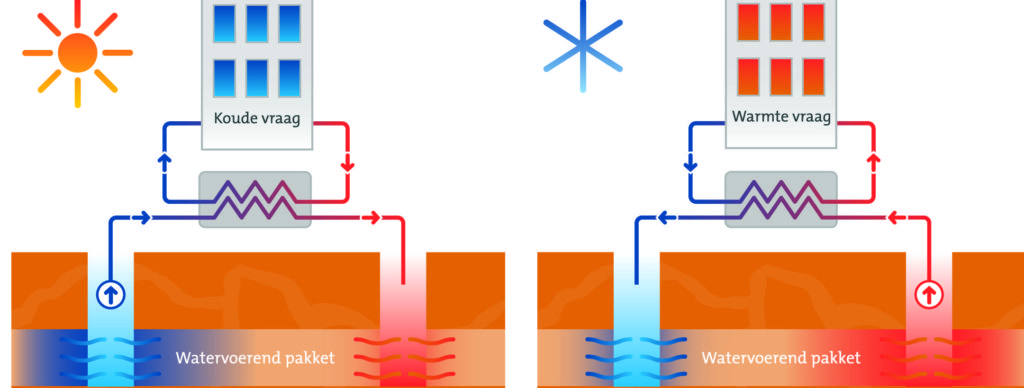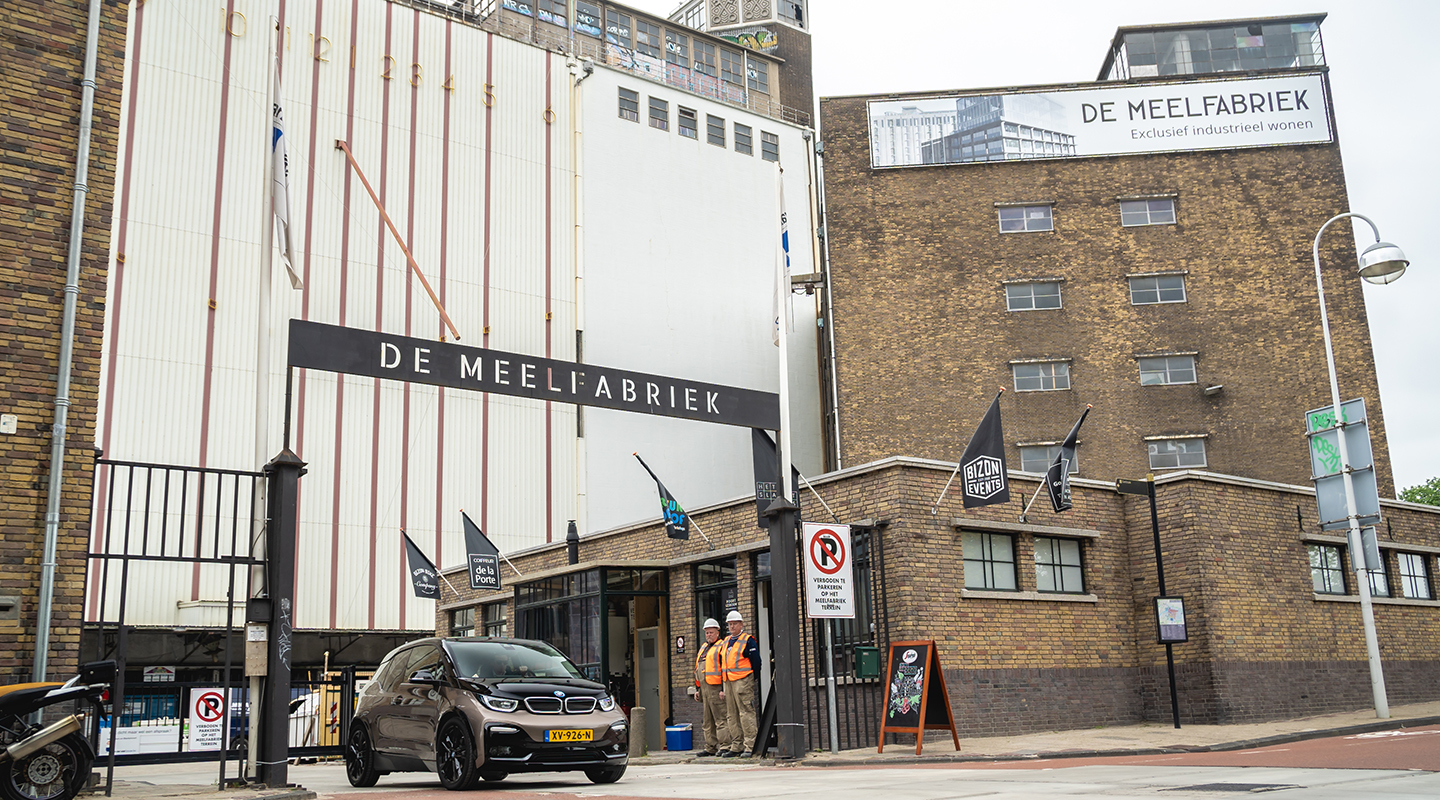PROGRESSIVE IN SUSTAINABILITY
De Meelfabriek is known as a textbook example of innovative area development with respect for monumental heritage and great attention to sustainability. With the purchase of an apartment in Meelpakhuis and Silotoren, you are opting for a project in which only sustainable energy sources are used. We are working with soil sources, heat and cold storage, heat pump technology and solar collectors that meet the energy needs. The buildings are completely gas-free. But sustainability goes further than this. Reuse of buildings is fundamentally more sustainable than new construction. Wherever possible we keep the buildings, where they are demolished we dispose of them for reuse elsewhere. We choose quality materials such as triple glazing for energy savings, low temperature heating, passive floor cooling in summer, LED lighting, heat recovery from ventilation air, etc. In addition, electric driving is stimulated by the supply of charging stations for all residents and visitors. And alternative transport solutions are sought and stimulated. In all layers of the project, we are constantly looking for the right interpretation and in doing so, we remain open to new developments.
Choosing sustainable alternatives involves major investments. De Meelfabriek is convinced that the investments are worthwhile for both the users and the environment. To reinforce this conviction, we initiate a high-profile campaign: all buyers of apartments in the Meelpakhuis and the Silotoren receive 10 years of energy in their purchase agreement.
Developer and owner of De Meelfabriek, Ab van der Wiel explains: ‘We invest approximately 20% of the building sum per apartment in sustainability measures. A considerable cost item, but a matter of course for us as developer of De Meelfabriek. If you want to transform monuments into buildings that are future-oriented, then sustainability choices are a must. This provides enormous benefits for the user in the long term. Despite the amount of attention for this in the current media, the implementation is still difficult. Banks only encourage sustainability in part by means of mortgage schemes. If you want to get it right, this is certainly not enough. In order to entice consumers to make high investments, it must be clear what the benefits will be. In the case of De Meelfabriek, we have already opted for the high investments. And because the buyer therefore also chooses this when purchasing his or her apartment – either unconsciously or consciously – we want to reward this choice’.

SUSTAINABILITY
De Meelfabriek is clearly committed to pursuing sustainable business practices and implements them in different areas, starting with the buildings themselves. This includes using sustainable materials and demountable building components and repurposing existing listed buildings into a functional, timeless design for De Meelfabriek, which will make users much less inclined to renovate again in the short term. The aim is to minimise energy consumption by reducing waste and make optimum use of energy from renewable sources.
Visitors and residents will also be encouraged to use alternative means of transport by providing shared cars, rental bikes and an electric boat, added to which there will be plenty of charging points in the underground car park in order to facilitate the transition to electric mobility.
Entrepreneurs who make a conscious commitment to be sustainable are a great asset to us, and likewise it is no coincidence that they feel right at home in De Meelfabriek.
READ DETAILED INFORMATION >
One of the core values of De Meelfabriek is sustainability. All the parties involved are therefore making every effort to create an optimum sustainable concept, starting with the buildings themselves. By using sustainable materials and demountable building components and repurposing existing listed buildings, De Meelfabriek is working hard to be as sustainable as possible.
Reusing designated heritage assets means, for example, that the buildings, stones, concrete floors and roofs, steel window frames and other materials do not need to be made, transported and processed again, according to Ed Zwart, Technical Director of construction firm Van der Wiel Bouw. ‘That saves a lot of energy and raw materials, and forms an excellent starting point for the sustainability that is at the heart of the entire project and process.’
Trias Energetica
What’s more, Van der Wiel Bouw has opted for Trias Energetica, a three-step strategy to create an energy-efficient design, for the redevelopment of the various buildings. The three steps provide basic rules for sustainable building design. First, limit energy consumption by preventing waste. Ed Zwart: ‘We are reducing energy demand in the buildings of De Meelfabriek by insulating floors, roofs and outer walls, and we are installing HR++ high-efficiency glazing and/or extremely high-performance triple glazing.’
The buildings are equipped with a low-temperature heating system. ‘Underfloor and wall heating is usually the preferred method: with water at “only” 40 degrees, the rooms reach a comfortable temperature. A low supply water temperature also means that much less energy is required; a traditional boiler works at a temperature between 70 and 90 degrees, which costs a lot more energy. In the summer we also use the underfloor and wall system to provide passive cooling. The cold water comes out of the ground at almost no charge, so there’s no need for air conditioning.’
Other measures to be taken in De Meelfabriek include recovering heat energy from the ventilation air and making maximum use of energy-saving LED lighting, which can be controlled with light-sensitive and/or motion-sensitive switches according to the needs of the user.
Renewable sources
The second step in the Trias Energetica is to make maximum use of energy from renewable sources such as wind, water and sunlight. ‘We use all these options in De Meelfabriek,’ Ed adds. ‘For instance, fluid is pumped to a depth of 250 metres and then comes back up to the surface. This is known as the ground-coupled heat exchanger system.’ (see further details below)
In addition to this system, De Meelfabriek has a warm roof, which is actually a floor heating system installed on the roof. ‘This can be used in the summer to produce hot water and by ensuring that the heat is properly removed via the hoses, the building in question also needs less cooling. For some buildings we use heat pumps to extract thermal energy from air – and that energy is also stored in a boiler tank.’ Finally, De Meelfabriek also generates energy from solar panels and solar thermal collectors on the roofs are used to produce hot water.
The third and final step is to use fossil fuels as efficiently as possible – or preferably not at all – to meet the remaining energy demand. This is also feasible, as Ed Zwart explains. ‘The electrical energy needed is purchased from a green supplier that generates electricity from wind turbines or solar parks.’ So there are no gas pipes at all, making De Meelfabriek a particularly sustainable project.
Sustainable transport
De Meelfabriek also ranks high in sustainability when it comes to transport. For example, the three-storey car park for 300 cars will have a large number of charging points for electric vehicles. The fact that it is completely underground, so that the cars will be out of sight, will also improve quality of life. Visitors and people who work in the complex can also choose to hire an electric car (BMW i3). Anyone who comes to De Meelfabriek by public transport, by bike or on foot can make use of this option whenever necessary, sharing where possible. Rental bikes are also available from the Bizon Bike Company, and Bizon Events operates an electric boat.
Not only has De Meelfabriek teamed up with this sustainable partner, it also applied the sustainability criterion when selecting the businesses that occupy the former Directiekantoor and the Poortgebouw, focusing on those that are committed to this goal, such as LeydenJar Technologies and Ghost Fishing.
Add to this the functional, timeless design of De Meelfabriek, which will make users much less inclined to renovate again in the short term, and it should be clear: you would be hard-pressed to find a more sustainable project than De Meelfabriek anywhere else in the Netherlands.
GROUND-COUPLED HEAT EXCHANGER SYSTEM
Fluid is pumped to a depth of 250 metres and comes back up to the surface a few degrees warmer. The temperature difference is due to the fact that the Earth has a near constant subterranean temperature of 12 to 15 degrees. The heat captured is then transferred to the storage system, e.g. a boiler. If you do this often enough, the boiler will eventually reach a temperature of 50-55 degrees, providing hot water for the underfloor heating or the shower. Energy from the Earth is free; only pumping requires electricity. In the summer, the process can be reversed, so that heat is extracted from a building warmed by the sun and is transferred to the ground, where it cools. If this colder water is then pumped through the building, it provides air conditioning.



